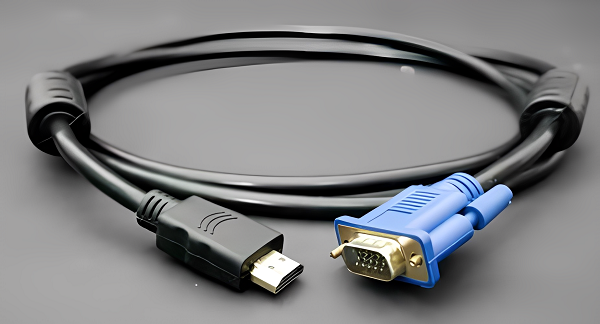Change is the only constant in the world of technology. This is especially true when it comes to the way we connect our devices. In this article, we will explore the evolution of video connectors, focusing on two major players: VGA (Video Graphics Array) and HDMI (High Definition Multimedia Interface).
VGA: The Old School
VGA, introduced by IBM in 1987, was the standard for graphics display for many years. It was the first analogue interface to be widely adopted and allowed for resolutions up to 640×480 pixels.
The VGA connector is easily recognizable by its 15-pin configuration, arranged in three rows of five. It carries analogue video signals, which means the signal can degrade over long cable lengths, leading to a lower-quality image. However, VGA has the advantage of being compatible with CRT (Cathode Ray Tube) monitors, which were prevalent at the time of its introduction.
Despite its age, VGA is still used today in some applications. For instance, many projectors and older monitors still have VGA ports, and it’s not uncommon to find VGA ports on some modern computers and laptops for backward compatibility.
VGA: The Technical Details
VGA Cables use analogue signals, which means it transmit information through a continuous signal. This differs from digital signals, which use discrete values to transmit information. Because of this, VGA can suffer from signal degradation, especially over long distances or poor-quality cables. This can result in a fuzzy or blurry image.
VGA supports a maximum resolution of 640×480 pixels, but many modern displays far exceed this. As a result, VGA Cables are not suitable for high-definition video.
HDMI: The New Age
HDMI, introduced in 2002, was designed for the digital age. It carries both digital video and audio signals, which means it can support high-definition video and multi-channel audio in a single cable. This reduces confusion and simplifies the setup process.
HDMI connectors come in various forms, including Type A (standard), Type C (mini), and Type D (micro). The standard Type A connector has 19 pins and supports most consumer devices such as TVs, monitors, and game consoles.
One of the significant advantages of HDMI is its ability to support higher resolutions and refresh rates, including 4K and 8K video. It also supports features like CEC (Consumer Electronics Control), which allows for controlling multiple devices from a single remote, and ARC (Audio Return Channel), which reduces the number of cables needed in a home theatre setup.
HDMI: The Technical Details
Unlike VGA, HDMI uses digital signals. This means it transmits information using binary data, which can be more resistant to degradation over long distances. HDMI supports a wide range of resolutions, including 720p, 1080p, 4K, and even 8K. It also supports various audio formats, including stereo, Dolby Digital, and DTS.
HDMI also includes support for CEC, which allows a user to control all CEC-enabled devices with one remote. For example, turning off the TV would also turn off the DVD player and the sound system. This can greatly simplify the user’s home theater system.
VGA vs. HDMI: The Comparison
When comparing VGA Cables and HDMI, it’s clear that HDMI offers superior performance. The digital signal does not degrade over a distance like an analog signal, resulting in a clearer, sharper image. HDMI’s ability to carry audio and video over a single cable also makes it a more convenient option.
However, VGA still has its place. For older equipment that doesn’t support digital interfaces, VGA may be the only option. Additionally, VGA cables can be quite long without signal amplification, making them suitable for certain uses, such as in classrooms or conference rooms where the display might be far from the source.
DVI: The Bridge Between VGA and HDMI
Digital Visual Interface (DVI) was introduced in 1999 as a successor to VGA Cables. It was one of the first widely adopted digital display interfaces and played a crucial role in the transition from analogue to digital video. DVI can transmit both analogue and digital signals, making it compatible with both old (VGA) and new (HDMI) displays. However, DVI does not carry audio signals, which is one of its main limitations compared to HDMI.
DisplayPort: The Challenger
DisplayPort, introduced by the VESA association in 2006, is a high-performance interface designed to replace both VGA and DVI. It supports high resolutions, high refresh rates, and multiple video streams over a single cable. DisplayPort also carries audio and other forms of data, making it a versatile choice for professional and home use.
Thunderbolt: The All-in-One Solution
Thunderbolt, co-developed by Intel and Apple, is a revolutionary interface that combines data, video, audio, and power in a single connection. Thunderbolt ports are found on many Apple devices and some high-end PCs. They use the same connector as USB-C and are compatible with USB-C devices. Thunderbolt 3 and 4 support DisplayPort 1.2 and 1.4 respectively, allowing them to drive multiple 4K displays or a single 8K display.
The Verdict
While VGA Cables served us well in the past, HDMI is the clear winner in the modern age. Its superior performance, combined with its convenience and advanced features, make it the go-to choice for connecting modern devices.
while VGA has its place in the annals of tech history, HDMI is the standard for modern digital video connectivity. As we continue to demand higher-quality video and audio, along with convenience and simplicity, HDMI and its successors will continue to lead the way.
Looking Forward: The Future of Video Connectors
As we look to the future, it’s clear that the world of video connectors will continue to evolve. New technologies like DisplayPort and USB-C are already challenging HDMI for the top spot. These new interfaces offer even higher resolutions, faster refresh rates, and more advanced features.
For example, DisplayPort 2.0, released in 2019, supports resolutions up to 16K and refresh rates up to 240Hz. It also includes support for advanced features like multi-stream transport, which allows multiple video streams to be sent over a single cable.
Similarly, USB-C, while not a dedicated video interface, is becoming increasingly popular due to its versatility. A single USB-C port can handle data transfer, video output, and power delivery. This makes it an attractive option for modern devices like laptops and smartphones, which value portability and simplicity.
As technology continues to advance, we can expect to see even more innovation in the world of video connectors. Who knows what the future holds? But one thing is for sure: the days of VGA are numbered.
Conclusion
The evolution of video connectors from VGA to HDMI and beyond is a testament to the rapid pace of technological advancement. While VGA Cables laid the groundwork for graphics display, HDMI took it to the next level by integrating audio and video signals into a single digital interface. Today, newer interfaces like DisplayPort, Thunderbolt, and USB-C are pushing the boundaries even further, offering higher performance, more features, and greater versatility. As we continue to demand better quality, convenience, and simplicity in our devices, these technologies will undoubtedly play a crucial role in shaping the future of digital connectivity. The journey from VGA to HDMI and beyond is not just a story of technological progress, but also a reflection of our relentless pursuit of better, more efficient ways to communicate and interact with the world around us. It’s a fascinating journey and one that is far from over. As we look forward to the future, one thing is certain: the world of video connectors will continue to evolve, bringing us ever closer to the ultimate goal of seamless, high-quality digital connectivity.


